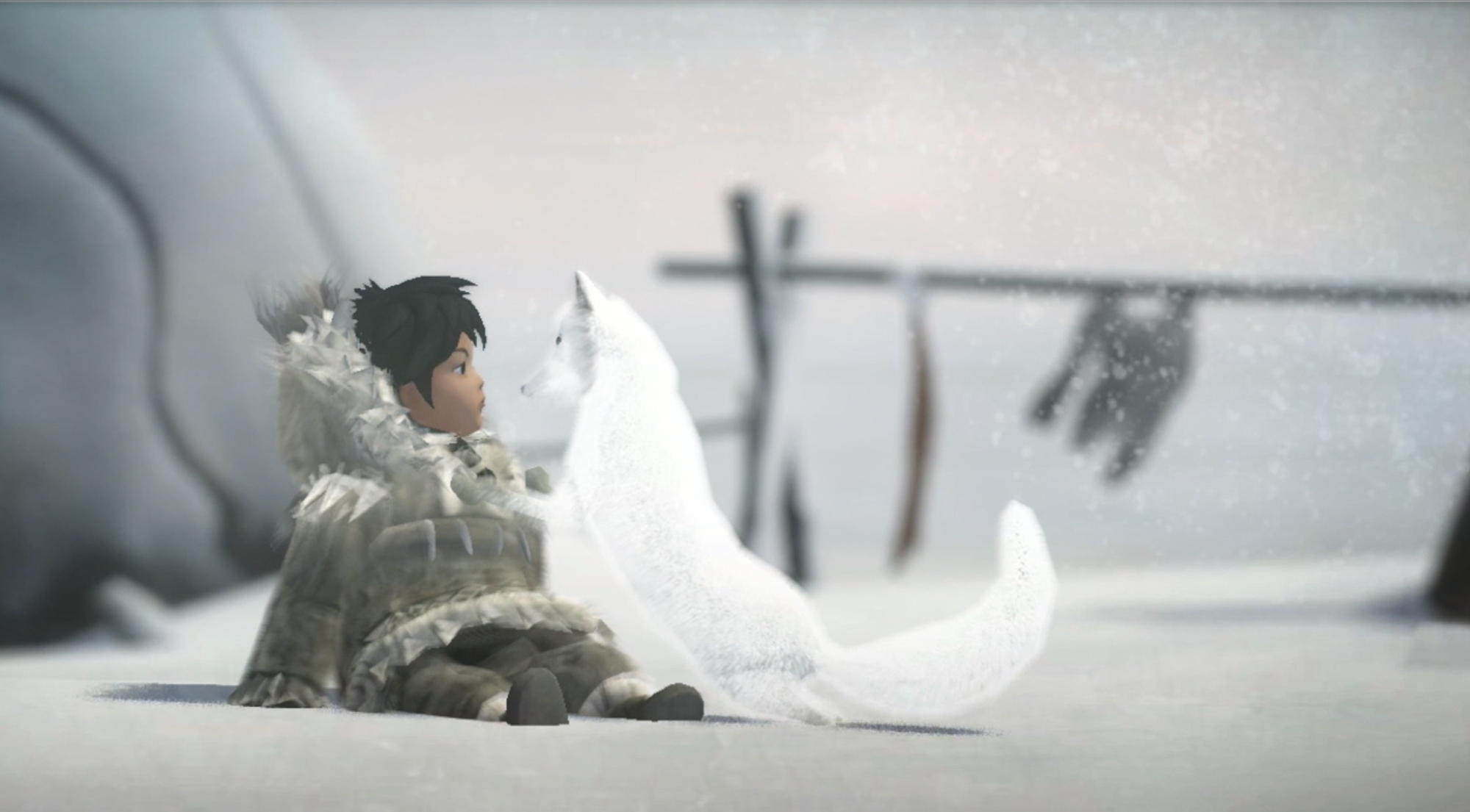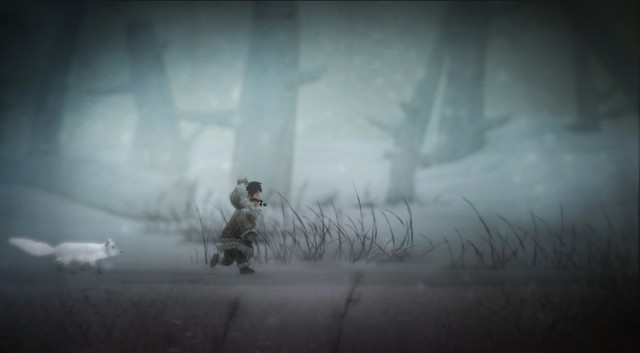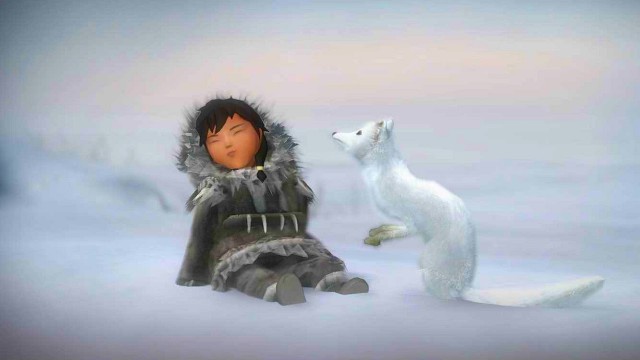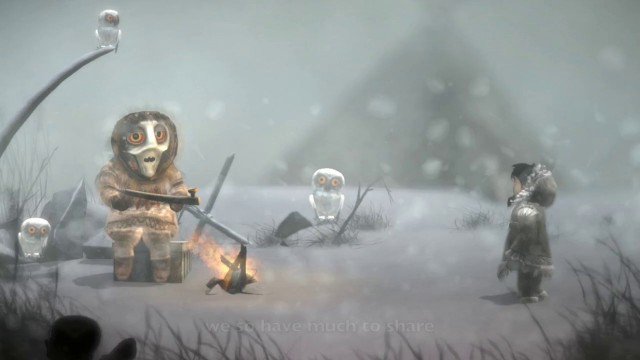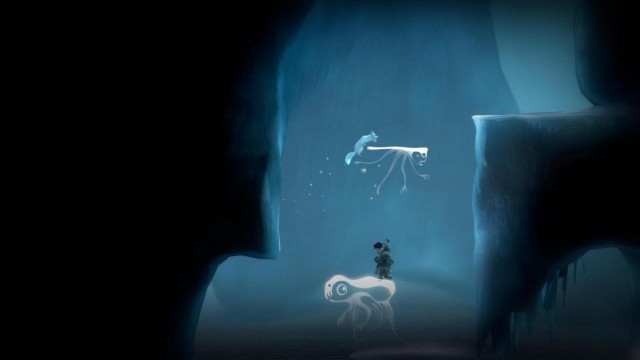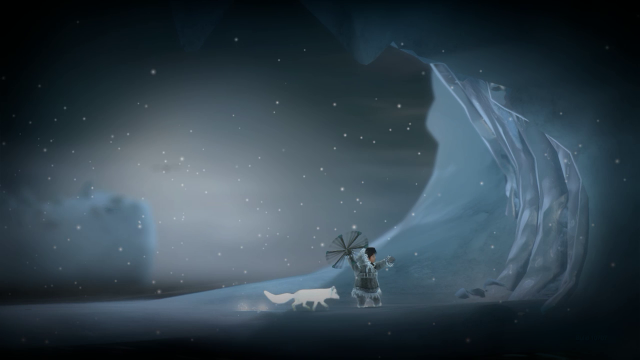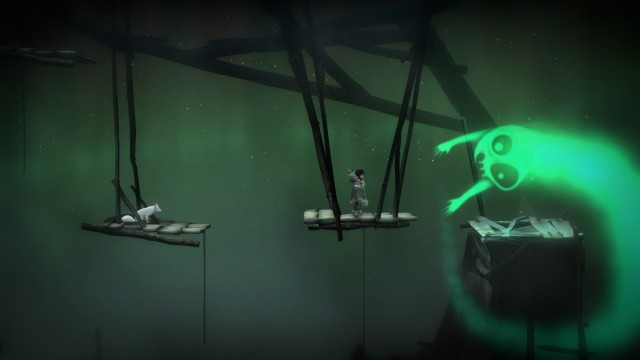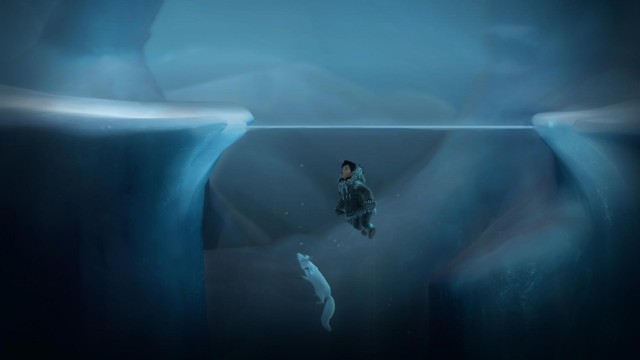UPDATE: While our review of Never Alone primarily focuses on the original PC, PS4 and Xbox One versions, we have updated the review with an additional section to deliver impressions of the belated Wii U version.
If you need proof that video games have joined the forefront of storytelling, well, there’s plenty of that. Still, few recent games have demonstrated a storytelling pedigree on par with Never Alone, a game developed by Upper One Games, a new studio founded entirely by indigenous developers, in collaboration with New York-based E-Line Media, with their first game having the direct input and participation of the indigenous Inupiaq tribe of Alaska.
For those unaware, many indigenous tribes throughout North America use storytelling not just for entertainment, but also for education and discipline. Storytelling is a core part of indigenous communication and record-keeping, which is why gamers should be pretty honoured that the medium has been recognized and adopted by an indigenous culture and fully indigenous developer. It’s another very big step for the gaming industry, and another way for games to be more inclusive to all the world’s cultures.
But, the question remains, with all of its awe, inspiration and celebration, is Never Alone actually a good game? Well, yes and no.
First, if you don’t have someone to play the game with, you’re going to be in for a much bumpier ride. It’s certainly possible to play through the entire game by yourself, but the later sections especially seem actively designed for a second player. Not only that, but the game is a bit of a technical mess, with pretty modest visuals, and a mess of glitches that both take away from the immersion, and hurt the physics and gameplay progression necessary to create a satisfying experience for the player. That’s before you consider the fact that it’s pretty short as well, barely stretching to a four-hour length before the credits roll.
Thus, while Never Alone definitely succeeds as an educational tool, it stumbles a bit as an actual game. For $14.99, it’s a bit tough to recommend to more discerning gamers. For those actively interested in learning about the Inupiaq tribe however, or get an idea of a Northern indigenous culture and lifestyle in general, Never Alone is worth the download, even if you’ll possibly want to grab it on sale for the best value.
Never Alone carries plenty of inspiration in its art style, even if its actual graphical horsepower isn’t anything special.
With that said, the authentic use of scrimshaw, along with the cool atmospheric effects and smooth 30fps animation create a wonderful sense of immersion in Northern indigenous culture. There is no doubt that this is a wholly authentic Inupiaq product, and for non-indigenous folks especially, this immediately creates an incredible sense of wonder, with the service to a largely unknown culture complementing the visual style very nicely.
Some of the set pieces that unfold across Never Alone’s brief journey, including the inside of a whale and a treacherous, snow-covered forest, to name a couple, all look pretty sharp as well. The character models are a bit less-defined though, especially when viewed up close, where they look like they belong on the middle-tier catalogue of the Xbox 360 and PS3. Still, there is great care put into creating the world of Never Alone, which feels simultaneously credible and surreal.
While you can potentially wring a tad more out of the graphics on optimal PC settings, you’d be hard-pressed to tell the difference between the three versions of Never Alone for the most part. The PS4 and Xbox One versions both appear to run at native 1080p resolution, with a stable 30fps framerate, so console gamers won’t find a contrast between Sony’s and Microsoft’s consoles. PC gamers however might be a bit more frustrated, since the system requirements and technical flexibility in the PC version are pretty rigid, and don’t give you many avenues to soup up the game’s performance on high-end rigs. Honestly, Never Alone seems largely built for the set performance of consoles, with the PC version feeling like an afterthought.
Still, Never Alone isn’t about wowing you with technology. It’s a game that places education before anything else, and while it has enough visual polish to get by, it will no doubt look and run pretty modestly compared to most other modern games.
Never Alone is virtually entirely devoid of music, and relies entirely on the blizzard winds and buckling wood structures of your journey to complement the game’s events entirely. This does create an added sense of immersion and isolation however, and works remarkably in the game’s favour.
The sound mixing is a little bit quiet with everything but the environmental effects, but perhaps that’s intentional. The Inupiaq have thrived in a harsh Northern environment for thousands of years after all, so it makes sense that the game is designed in such a manner to have the whims of nature take precedence over everything and anything else you may hear. Even the panicked death cries of your characters are very understated, and often drowned out by the freezing winds.
The scrimshaw cutscenes are narrated by an Inupiaq elder speaking the native tongue of the tribe, with English subtitles. This helps to create the idea that the story unfolding is being authentically told to you, as it would to an Inupiaq child. The game effectively creates a way to pass on Inupiaq stories to non-Inupiaq people this way, while also involving them in the culture, and showing how their method of communication and storytelling is appealing, even for us gamers who have been spoiled by larger-than-life triple-A games, blockbuster movies and what have you.
In many respects, the audio is one of the biggest highlights of Never Alone, and helps to compensate for the more modest visuals. On a potent home theatre system especially, the game is a joy to listen to, and really sucks you into the harsh Northern world of the Inupiaq quite effortlessly!
In Never Alone, you control two characters; The lost Inupiaq girl, Nuna, and the spirit of an Arctic fox that is guiding her on her journey home.
When playing solo, you use a button to switch between Nuna and the fox, with both having unique capabilities to utilize over the course of the linear adventure. Nuna for example can push and pull objects, while only the fox can get through small spaces. It’s your usual indie puzzle-platformer mechanics.
I won’t lie, Never Alone is pretty basic at its core. It’s the bare fundamentals of what you would expect in an indie puzzle-platformer, with the co-op mechanic adding some more uniqueness. Like I said however, you’ll enjoy it a lot more if you have someone pick up another controller and join you. Some of the later obstacles especially require very quick movement and responses by both Nuna and the fox, and this is a lot more of a hassle to do solo, since you can only control one character at a time for the most part, leading to some frustrating portions that border on outright demanding a second player. The A.I. does make the other character follow to a point, but it often can’t be trusted.
This becomes especially true when Nuna gains the ability to use the bola, which you use by drawing the right stick to the left, tilting, and then flicking it to the right quickly. If you mess up the motion in any way, Nuna doesn’t do anything. Needless to say, the bola controls are pretty fussy, and during sequences where you have to aim it properly to get rid of ice in your way for example, the mechanic can be a real hassle. The bola is also the biggest reason why PC players should absolutely bring a gamepad as well. Trying to aim and throw the bola with a mouse and keyboard is no doubt going to be a nightmare!
Similarly, the closest thing that Never Alone has to boss fights, which still unfold like puzzles, require a heavy degree of co-operation between Nuna and the fox, and often switching between the two very quickly. If you’re playing solo, this also means that you have to make sure that the character you quickly aborted controlling is not left in harm’s way, which will have you booted back to the previous checkpoint, though thankfully, checkpoints in Never Alone are extremely generous.
Even the collectibles of Never Alone, which come in the form of owls that give you ‘Cultural Insights’, are very generous. You’ll stumble upon almost all of them in plain sight by just playing the game normally. Even if you miss one, you can quickly go back and scoop it up via an extensive Chapter Select option on the main menu. This makes rounding up every achievement/trophy in the game very easy to do, especially since all of the others are simply awarded to you at set points during normal gameplay.
Still, the ease with which players can find the Cultural Insights feels intentional. In order to get the last achievement/trophy, you must watch every Cultural Insight in its entirety as well, with all of them telling a bit about Inupiaq culture and how it still thrives today in Alaska, and how Northern indigenous people live and function in their own society. If you’re open to an education on Northern indigenous people, these make for very cool and rewarding collectibles, even if they also mean that getting 100% completion in Never Alone and being left with no reason to ever play it again is also very quick and easy.
Still, however straightforward the gameplay is, the journey feels rewarding, even if very unchallenging for co-op players in particular. Beyond some of the frustrations that come with trying to control two characters by yourself, the most annoying setbacks in Never Alone come from a pretty sizeable helping of glitches, which frequently pop up with the physics. Nuna especially has a habit of getting stuck in warped animation if she falls into the wrong obstacle, suddenly warping away and dying, while even the fox can sometimes get stuck in the scenery, or jitter wildly during its death animation, which takes away from the supposed sadness of Nuna weeping over the loss of her spirit friend.
Sadly, the glitches are a problem on all three platforms too. Granted, some of them can be funny, especially in regards to some of the weird animation errors that sometimes play out, but when you arbitrarily miss a platform during a jump because the game seized up, or suddenly can’t swing on a rope properly for no real reason, that’s when the bugs become irritating. Not only that, but the moderate count of glitches in Never Alone also hurt the immersion significantly, taking you out of the story, and reminding you that you’re playing a video game, and a somewhat patchy one at that.
Thus, Never Alone is very simple and a bit unpolished in terms of its actual gameplay, but the journey is worth it if you’re looking for insight. Perhaps that’s a tall order amongst gamers who would rather enjoy top-tier production values and unyielding thrills, but it can still be said then that Never Alone isn’t afraid to defy gamer convention. It’s limited to those actively wanting to learn, but the way that Never Alone incorporates its educational value into the video game medium is at least praiseworthy, even if Upper One Games’ first stab at a gameplay experience definitely feels like a rough draft.
Never Alone is apparently based on an actual Inupiaq myth, though with some changes, namely that the myth’s lead is a boy, while the game’s lead is a girl. The fact that the story is taken from Inupiaq lore helps to make it all the more appealing to learn about however, especially after you get the sense that this is just one of thousands, perhaps tens of thousands of myths that this culture has told over a period of centuries.
The resolution of the story is pretty neat as well. It’s not just a simple story of Nuna getting separated from her village and trying to find her way home. The game also incorporates the element of an eternal blizzard that threatens the life of Nuna, and how she comes to investigate and respect the laws of nature. You have to see it unfold to understand it, but by the end, you really will get a sense of what makes indigenous storytelling such a cool thing!
Again, the story is not terribly lengthy, and is largely straightforward. Still, there’s a sense of awe in sharing in this piece of Inupiaq history, which translates reasonably well to video games. It’s nothing that will raise the bar for video game storytelling, but it proves that these kinds of treasured indigenous stories can certainly work in the video game medium, opening the door for all sorts of possibilities by indigenous developers from around the world. Like I said, regardless of what you ultimately get out of Never Alone’s story, that’s a cause worth celebrating for gaming!
Never Alone has taken over six additional months to finally come to Nintendo’s console, but it’s now available for the Wii U. For the most part, the Wii U version doesn’t feature any drastic gameplay alterations from the original PC, PS4 or Xbox One builds of the game. It does however manage to match their visual prowess and resolution for the most part, which is very commendable. Another advantage of the Wii U build is that it supports off-TV play, and can be entirely played on the Wii U Gamepad Screen if you choose, including the viewing of the Cultural Insights, which is a great touch!
Unfortunately though, despite the Wii U version’s added development time, many of the game’s technical issues from the original versions still remain on Nintendo’s console. The Wii U version of Never Alone is still a glitchy mess at times, with framerate stutters that are slightly more frequent than the other three versions, along with the occasional tendency for Nuna and Fox to end up stuck in platforms and falling through floors. At worst, the Wii U version of the game can even hard freeze at times, which occasionally fixes itself after a few seconds, but may also force players to hard reboot their entire Wii U console by turning it on and off again.
Those who would play Never Alone on Wii U should also be aware that the game requires something like a Wii U Pro Contoller to play the co-op that the game is so dependent on, plus the Wii U version naturally doesn’t feature achievements/trophies to amass, unlike the PC, PS4 and Xbox One versions. Fortunately, the added development time wasn’t a complete waste however, as the Wii U version packs in around twenty exclusive Cultural Insights to track down, which helps to compensate for the lack of achievements/trophies in this version.
The Wii U version of Never Alone is no better or worse than any of the others in the end, and if you’re interested in the game, and consider the Wii U to be your platform of choice, then Never Alone gives you roughly the same experience that you would have on the game’s original three supported platforms. The Wii U-exclusive Cultural Insight additions aren’t really enough to justify a double-dip if you already own one of the other three versions of the game though, and the fact that the Wii U version failed to clean up the glitches and technical issues from the original three builds is a massive missed opportunity in terms of increasing this game’s appeal on Nintendo’s platform.
Never Alone is a commendable first effort from Upper One Games, even if it’s also a novice effort. Still, for its flaws and brevity, Never Alone is a great first step when it comes to opening the doors for a greater welcome to indigenous communities in the world of gaming. It functions as a sort of interactive documentary, which feels innovative in and of itself, and while its focus is on education over gameplay, it undeniably proves that this kind of education and gameplay can be married into a cohesive, appealing whole, even if it will take practice, and no doubt some failed attempts.
If the idea of absorbing a foreign culture is appealing to you however, then Never Alone is a very satisfying experience, however short and simple it is. Regardless of which platform you get it for, the experience is virtually the same, though again, the PS4 and Xbox One versions seem to have taken development precedence over the PC version, so hopefully you have gamepads handy, and aren’t interested in fiddling too much with the settings in that case. Bear that in mind.
In the end though, Never Alone won’t turn the heads of avid gamers, but it still serves its purpose of educating and entertaining at the same time, with authentic input and assets from real Inupiaq people. The virtue of its existence is perhaps the greatest thing about it, along with the fact that learning about something here is an even greater reward than reaching an end point, or amassing achievements/trophies. Never Alone certainly doesn’t disparage gaming in those respects though, and embraces the medium proudly and confidently. It’s an experiment that is worth continuing and perfecting, and it’s a great way to learn something new, even if the gameplay may leave you wanting. Putting aside any gameplay criticisms however, Never Alone still represents something greater for the medium and for indigenous culture that can’t be denied; Progress.
As the adage goes, progress, not perfection.

